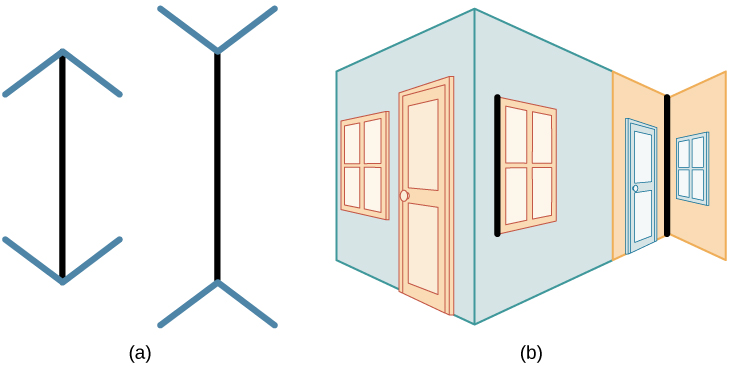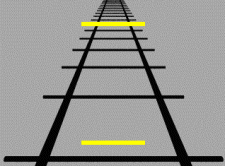Chapter 7: Depth perception
7.6. Size Illusions
One common size illusion is the Muller-Lyer illusion demonstrated in Figure 7.14 a below. The two black lines are physically the same length but to many of us, the one on the right seems longer. We are clearly influenced by the “fins” on the end of the lines. We can see a similar issue in Figure 17.14 b where the line on the side of the window looks shorter than the one in the intersection of the two walls. We can see that in b) we are probably being influenced by our perception of how near or far away the lines are and the size-distance scaling equation helps to explain our perception. But what about in 7.14 a? Gregory (1966) suggested that we perceive the figure on the left to be like an external corner (such as between the two blue walls in Figure 7.14 b) whereas the figure on the right is more like an internal corner – like the one between the yellow walls. The blue corner seems closer to us (D is small) whereas the yellow corner seems further away (D) is large.

The Ponzo illusion
The Ponzo illusion as seen in Figure 7.15 is where a pair of converging lines distorts the perception of two identically sized lines (or objects) sitting on them. The illusion can be explained by the size-distance scaling equation where the line on top appears to be further away than the line below. The illusion of distance is provided by linear perspective.

Ames Room
An Ames room is a distorted room used to create an optical illusion about the sizes of people in the room (Figure 7.16). Upon viewing people or objects within an Ames room, there is a loss of normal perspective. As a result, a person standing in one corner appears to the observer to be significantly larger than a person standing in the opposite corner while the room appears to be a normal rectangular shape. This is because our brain assumes that D in the size-distance scaling equation is the same for both people, in reality the person who seems really big is much closer to us.

Learn more about the Ames room illusion by watching this video!
Materials in this Chapter came from:
Dommett, E. (2023). Lighting the world: our sense of vision. In C. Hall (Ed). Introduction to biological psychology. University of Sussex. https://doi.org/10.20919/ZDGF9829
Grose-Fifer, J., Spielman, R. M., Dumper, K., Jenkins, W., Lacombe, A., Lovett, M., & Perlmutter, M. (2021). Introduction to Psychology (A critical approach). CUNY Pressbooks. https://pressbooks.cuny.edu/jjcpsy101/
Cheryl Olman & Mohamed Ahmed, Molly Baugh, Francel Colon-Acosta, Jarod Davis, Kaelyn Dezell, Lucas Gaffney, Madelynn Gibbons, Trevor Graham, Katherine Hebig, Noah Hjelle, and Wanlin Hu (Students of 3031 at the University of Minnesota). https://pressbooks.umn.edu/sensationandperception/
References:
A.D.A.M. Inc., MEDLINE. (2024). Strabismus.https://medlineplus.gov/ency/article/001004.htm
Carmel, D., Arcaro, M., Kastner, S., & Hasson, U. (2010). How to create and use binocular rivalry. Journal of Visualized Experiments, (45), 2030. https://doi.org/10.3791/2030
Cisneros-Franco, J. M., Voss, P., Thomas, M. E., & de Villers-Sidani, E. (2020). Critical periods of brain development. In Handbook of clinical neurology (Vol. 173, pp. 75-88). Elsevier.
Crick F. & Koch, C. (1990). Towards a neurobiological theory of consciousness. Seminars in the Neurosciences, 2, 263–275
Encyclopaedia Britannica. (n.d.) Afterimage. https://www.britannica.com/science/afterimage
Gregory, R. L. (1966). Optical illusions. Nature, 209(5020), 328-328.
National Eye Institute, (2024). Amblyopia (Lazy Eye). National Institutes of Health. https://www.nei.nih.gov/learn-about-eye-health/eye-conditions-and-diseases/amblyopia-lazy-eye
New World Encyclopedia (2023). Ames Room https://www.newworldencyclopedia.org/entry/Ames_room
New World Encyclopedia (n.d.) Ponzo illusion. https://www.newworldencyclopedia.org/entry/Ponzo_illusion
Pascalis, O., Fort, M., & Quinn, P. C. (2020). Development of face processing: Are there critical or sensitive periods? Current Opinion in Behavioral Sciences, 36, 7–12. https://doi.org/10.1016/j.cobeha.2020.05.005
Rice University (2014). OpenStax, Psychology Revisions Chapter 27 Vision. https://opentext.wsu.edu/ospsychrevisions/chapter/vision/
Wheatstone C. (1838). Contributions to the physiology of vision.—Part the first. On some remarkable, and hitherto unobserved, phenomena of binocular vision. Philosophical Transactions of the Royal Society of London. 128, 371–394.
